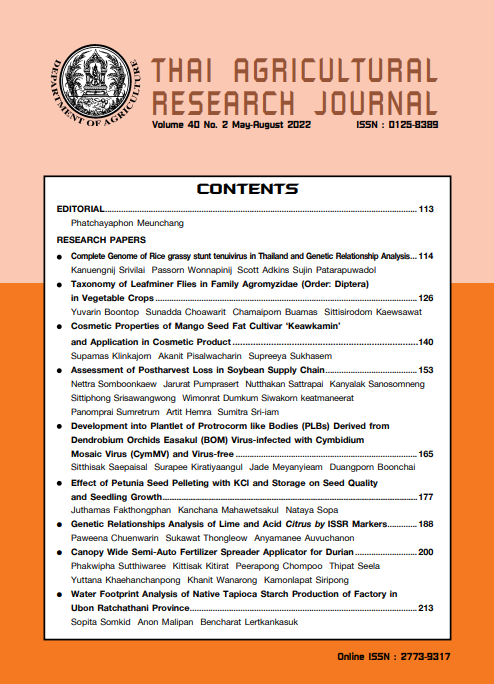Water Footprint Analysis of Native Tapioca Starch Production of Factory in Ubon Ratchathani Province
DOI:
https://doi.org/10.14456/thaidoa-agres.2022.18Keywords:
water footprint, cassava, native tapioca starchAbstract
The water footprint of starch factory in native tapioca starch production is one of the important requirement of the upcoming agricultural exports. Tapioca starch is an important agricultural export of Thailand. Water footprint of world native tapioca starch relatively high. Therefore, to collect data in real area from a case study of cassava starch factory, Ubon Ratchathani Province. Based on the analysis of water footprint of native starch production in the 2017/8-2020 by questioning and interviewing information in each production process. It found that 1 ton of native starch uses an average 4.35 tons of cassava fresh root, calculated from the amount of starch in the fresh root in average 23%. The highest water consumption was in the fresh root washing process, 57% of the total water consumption in the production process. When analyzing the actual water consumption and the virtual water volume in the starch production, found that water footprint of native starch 1 ton in the factory was 38.1 m3, separate in green, blue and grey were 0, 18.7 and 12.5 m3., respectively. When embedded with water footprint of raw materials 253 m3/ton fresh root yield and fraction of product, the native tapioca starch products 1 ton had water footprint of 1,132.2 m3 separate in green, blue and grey were 925, 18.7 and 187.5 m3, respectively. The database obtained from this research will support water footprint product labeling data, improve water consumption management in the processing process and enable environmentally friendly production in the future.
References
ขนิษฐา มีวาสนา. 2556. วอเตอร์และคาร์บอนฟุตพริ้นท์ของกระบวนการผลิตแป้งมันสำปะหลัง
ในภาคตะวันออกเฉียงเหนือตอนล่างของประเทศไทย. รายงานการวิจัยโครงการรับทุนอุดหนุนการวิจัยจากมหาวิทยาลัยเทคโนโลยีสุรนารี ปีงบประมาณ พ.ศ. 2555. 43 หน้า.
ชัยวัช โซวเจริญสุข .2563.แนวโน้มธุรกิจ/อุตสาหกรรม 2563-2565 : มันสำปะหลัง. แหล่งข้อมูล : https://www.krungsri.com/th/research/industry/industry-outlook/agriculture/cassava/IO/io-cassava-20. สืบค้น : 12 ธันวาคม 2564.
ชินาธิปกรณ์ พงศ์ภิญโญภาพ และ ธำรงรัตน์ มุ่งเจริญ. 2554. วอเตอร์ฟุตพริ้นท์ของกระบวนการผลิตเอทานอลจากมันสำปะหลังในประเทศไทย. วิศวกรรมสาร มก. 75 (24) 41-52.
ธารทิพย์ เศรษฐชาญวิทย์. 2559. การประยุกต์หลักการประเมินวัฏจักรชีวิตเพื่อประเมินคาร์บอนฟุตพริ้นท์และวอเตอร์ฟุตพริ้นท์ของอุตสาหกรรมแป้งมันสำปะหลัง. ว.พัฒนบริหารศาสตร์ 56 (3): 221-252.
ประกาศกระทรวงพาณิชย์ เรื่อง กำหนดให้แป้งมันสำปะหลังเป็นสินค้ามาตรฐานสินค้าแป้งมันสำปะหลัง พ.ศ. 2562. 6 มีนาคม 2562 ราชกิจจานุเบกษา เล่ม 136 ตอนพิเศษ 56 ง หน้า 2.
ประกาศกระทรวงอุตสาหกรรม เรื่อง กำหนดมาตรฐานควบคุมการระบายน้ำทิ้งจากโรงงาน พ.ศ. 2560. 7 มิถุนายน 2560. เล่ม 134 ตอนพิเศษ 153 ง ราชกิจจานุเบกษา หน้า 11.
รุ่งทิวา เวทยะเวทิน และชีวินทร์ ลิ้มศิริ. 2562. ร่องรอยการใช้น้ำของมันสำปะหลังจังหวัดนครราชสีมา. ว.วิชาการ สมาคมสถาบันอุดมศึกษาเอกชนแห่งประเทศไทย ฉบับวิทยาศาสตร์และเทคโนโลยี. 8(2): 104-117.
สำนักงานมาตรฐานสินค้าเกษตรและอาหารแห่งชาติ. 2561. มาตรฐานสินค้าเกษตร มกษ. 8803-2561 กากมันสำปะหลัง. สำนักงานมาตรฐานสินค้าเกษตรและอาหารแห่งชาติ กระทรวงเกษตรและสหกรณ์. 5 หน้า.
Gerbens-Leenes, P.W., A.Y. Hoekstra and T.H. Van der Meer. 2009. The water footprint of energy from biomass: A quantitative assessment and consequences of an increasing share of bio-energy in energy supply. Ecological Economics. 28: 1052-1060.
Hoekstra, A.Y., A.K. Chapagain, M.M. Aldaya and M. M. Mekonnen. 2011. The Water Footprint Assessment Manual. Earthscan,UK. 203 pages.
Kaewjampa, N., N. Chaisri and C. Boonthaiwai. 2016. Comparison of water footprint of cassava and sugarcane in Northeast, Thailand. International Journal of Environmental and Rural Development. 7-2: 18-23.
Kongboon, R. and S. Sampattagul. 2012. The water footprint of sugarcane and cassava in northern Thailand. Procedia - Social and Behavioral Sciences. 40: 451–460.
Mekonnen, M. M. and A. Y. Hoekstra. 2011. The green, blue and grey water footprint of crops and derived crop products. Hydrol. Earth Syst. Sci. 15: 1577–1600.
Downloads
Published
How to Cite
Issue
Section
License
Copyright (c) 2022 Thai Agricultural Research Journal

This work is licensed under a Creative Commons Attribution-NonCommercial-NoDerivatives 4.0 International License.
Thai Agricultural Research Journal



